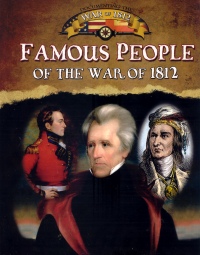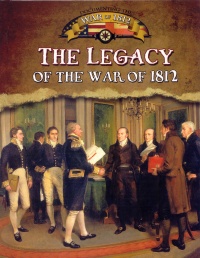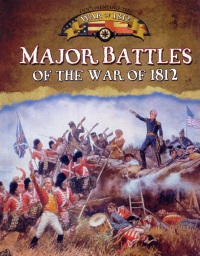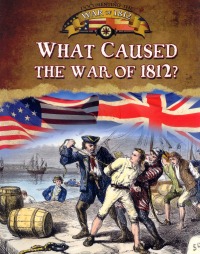| ________________
CM . . . . Volume XVIII Number 38 . . . . June 1, 2012
excerpts:
The perfectly timed release of the four-volume "Documenting the War of 1812" series coincides with the bicentennial of the war. Many heritage sites have planned reenactments for the purpose of commemorating this event. The War of 1812 actually lasted almost three years and was fought in three theaters of combat: the western theater, which encompassed the Great Lakes and surrounding territories; the Atlantic theater, both at sea and on the coast; and in the southern theater, which covered the Gulf Coast and the southern territories. Each title of the series is divided into four main chapters which document the causes, events, battles, principal players and the aftermath of the conflict. Much of the information is repeated in other volumes as are maps showing the locations of the various battles and what North America looked like- its states, territories, countries and land claim boundaries- prior to the start of the war. The text requires readers to be fully engaged because there is just so much information to absorb, far too much for the casual reader. Only true history buffs would persevere and read all four titles. Perhaps it would have been better to have combined all of the titles into one. There are small text boxes with additional facts as well as "In His Own Words" boxes which offer quotes from people who were directly involved in the war. A table of contents, a glossary, an index and a chronology are provided. Illustrations, shown on a sepia-toned parchment-like background, are many and varied. Maps, charts, drawings, line engravings, sketches, paintings, portraits, historical documents and contemporary photographs lend authenticity to the text. Famous People features 29 individuals, representative of both genders, military personnel, civilians, politicians and people of British, Canadian, American and aboriginal extraction. A single page is devoted to each of them, with a few paragraphs briefly describing their involvement in the war. The book is divided such that the individuals are grouped according to the "theater" in which they were involved. In the first chapter, the featured individuals all have something to do with the events leading up to the war, some examples being the Shawnee war chief, Tecumseh, who rallied several Native nations to form a confederacy to fight against the expansion of the United States into the natives' territory, and U.S, President James Madison, who was the first American president to declare war on another country. The following chapters focus on each of the three theaters. Sir Isaac Brock, Laura Secord and Charles de Salaberry are names which might be familiar to students, but for the most part, the individuals mentioned throughout the book are not well known. There are a couple of flaws in this title: firstly, there are so many individuals highlighted that it begins to get a tad confusing; and, secondly, not all of the people are featured in chronological order. Of all of the titles, this is the one that could easily be eliminated. The War of 1812 is said to have played a key role in shaping both the political geography of North America as it is known today and the relationships between Canada, the United States and Great Britain. Ending with the ratification of the Treaty of Ghent on February 16, 1815, the war's estimated loss of human lives was 35,000 (another title in the series gives 24,000 as the number of casualties), but only 5,000 of these were soldiers. Many civilians died from various causes, including disease and wounds. In The Legacy of the War of 1812, the author describes the aftermath of the war and how it affected all of the countries involved. It took some time to resolve many war-related issues, with the first to be settled being the boundary between the United States and British North America, American fishing rights and the disarmament of the navy ships on the Great Lakes. Westward expansion, the establishment of a national bank, and the creation of military schools and a standing army, so soldiers would always be at the ready, were some of the changes in the United States. One interesting bit of trivia is that the "Uncle Sam" character, created in 1813, comes from the initials "U.S." which were stamped on government shipments of weapons and supplies to the army. In Canada, people who had been loyal to Great Britain throughout the war were granted land while those who were disloyal had their land taken away and could be held for trial and charged with treason. Monuments honouring Major-General Isaac Brock were erected, and the government sought to preserve some of the battle sites which today are operated by Parks Canada. Natives lost their lands and were sent to live on government-established reserves, and slaves were given the opportunity to move to British territory. Four canals were built in Canada, three of them on the Ottawa River, and a new fort was built at Fort Henry to defend the St. Lawrence trade and shipping route. And, finally, Great Britain encouraged immigration from England, Scotland and Ireland to Canada. Major Battles of the War of 1812 is another title which in divided into chapters according to the three theaters in which the war was fought. There is brief background information about the events leading up to each battle as well as details about the conflict- its locations, commanders, and outcome. As an organizational tool, the information about the Great Lakes theater is presented under the headings of various frontiers (the Detroit Frontier and the Niagara Frontier, for example), but this can be confusing as the events are not necessarily chronological- with so many battles being waged, there was much happening simultaneously. Major battles in this theater include the Battle of Lake Erie, the Battle of Queenston Heights and the Battle of Crysler's Farm. Incidentally, the bravery of Laura Secord figures prominently in the British victory at the Battle of Beaver Dams in June 1813. At the outset of the war in the Atlantic theater, the British believed that their Royal Navy could not be bested. However, as the British soon found out, the fledgling U.S. Navy was a force to be reckoned with for its sailors were well trained and well paid volunteers who were eager to defend their country, unlike their counterparts who were often forced to join the navy through "impressment". The Americans also increased their naval forces by privateering, outfitting private merchant ships for war. After a few major losses, the British gained confidence with the capture of the U.S.S. Chesapeake by H.M.S. Shannon. Two interesting facts: firstly, when a large American flag was raised at Fort McHenry in Baltimore Harbor to indicate that the fort had withstood a 50-hour British attack, a local lawyer, Francis Scott Key, was inspired to write a poem entitled, "The Star-Spangled Banner", which later became the U.S. national anthem; secondly, prior to the war, the White House in Washington, D.C., was known as the President's House. However, when British soldiers invaded and burned several government buildings, white paint was used to cover the scorch marks. The southern theater included Florida, Louisiana and Alabama. Major battles fought in the south included the Battle of New Orleans in 1814, the Battle of Burnt Corn between the U.S. infantry and Native Americans near Fort Mims, Alabama, and another at Horseshoe Bend, Alabama, which resulted in the Creek Nation turning over 93,000 square kilometers of land to the U.S. government. What Caused the War of 1812? provides a snapshot of what life was like in Great Britain and in North America prior to the war. In this title, readers will find information about Britain's involvement in the Napoleonic wars (1803-1815), the French and English battle for power and land in the North American colonies, and the Loyalists who moved north to British North America following the American Revolutionary War. Though independence from Britain, westward expansion, and the British support of Native American tribes (including trading rifles for furs) in order to protect parts of Canada from the U.S. and to prevent expansion, were factors in the United States becoming involved in the war, one of the main reasons for the U.S. declaring war was that its freedom on the seas was in jeopardy, affecting its trade with other countries. Merchant vessels and sailors alike were captured, and any British deserters or American, but British-born sailors, were punished and forced to work for the Royal Navy. Free trade and sailors' rights were highly contested. The Embargo Act, passed by Congress in 1807, stopped trade between the United States and other countries, but farmers suffered because they could not sell their crops, merchants could not sell their goods and sailors and ship owners lost their jobs. This embargo was lifted in 1809, allowing Americans to trade with all other countries except France and Great Britain. Some people believe that if the communication between countries had been faster, the war might never have happened. One example of the slow pace of communication is the cancellation of the Orders-in-Council, British laws forbidding neutral countries from trading with France or its allies. Only two days after the cancellation announcement was made, Congress, not having heard the news, voted to go to war. In fact, it took five weeks for the message to get to them by ship. Timely, well researched and well intentioned, this series is useful as a resource but most certainly does not constitute a recreational read. It is beyond the scope and interest of the average reader who will find it rather lackluster and repetitive with far too much information to digest. Recommended. Gail Hamilton is a former teacher-librarian in Winnipeg, MB.
To comment
on this title or this review, send mail to cm@umanitoba.ca.
Copyright © the Manitoba Library Association. Reproduction for personal
use is permitted only if this copyright notice is maintained. Any
other reproduction is prohibited without permission.
NEXT REVIEW |
TABLE OF CONTENTS FOR THIS ISSUE
- June 1, 2012.
AUTHORS |
TITLES |
MEDIA REVIEWS |
PROFILES |
BACK ISSUES |
SEARCH |
CMARCHIVE |
HOME |



